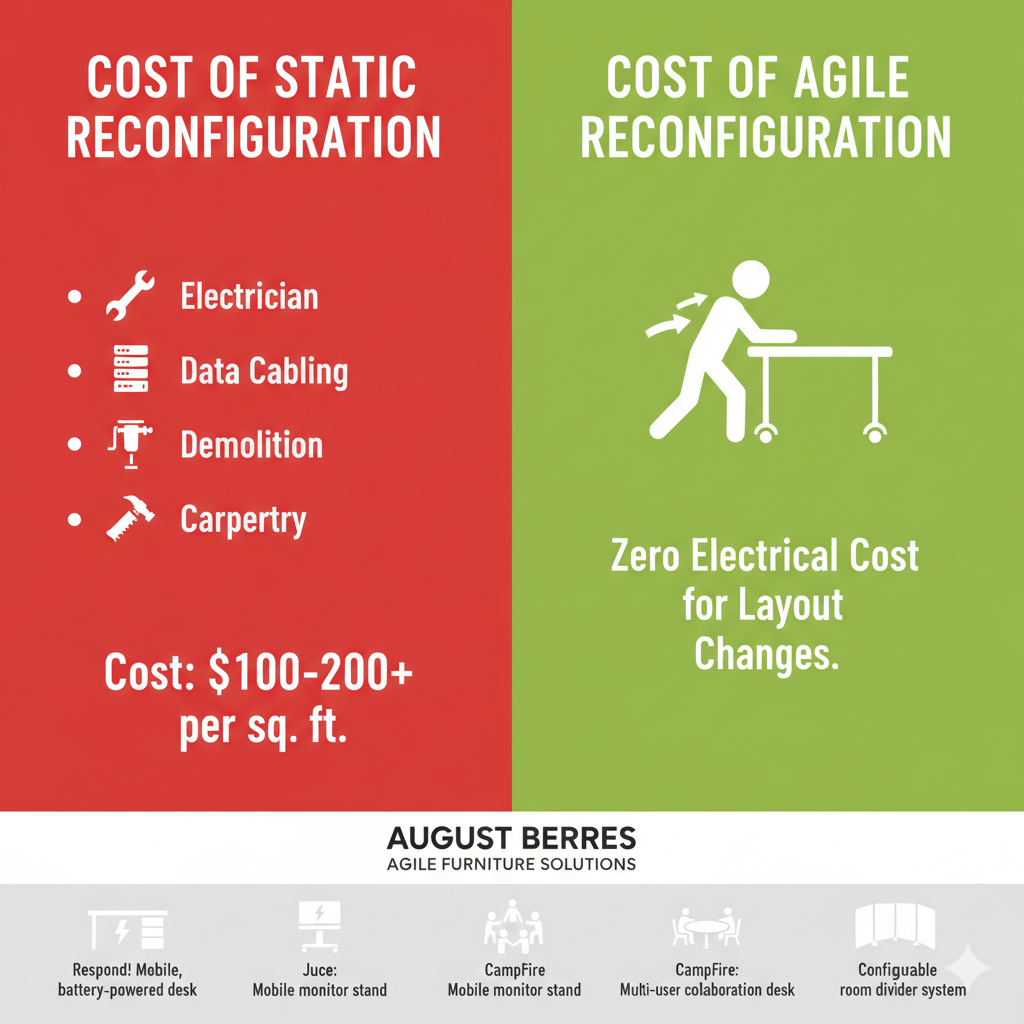The 83% Crash: Why the Assigned Desk is Extinct and How Agile Retrofits Will Unlock Profit
By Robert Kroon
Summary
The era of 1:1 assigned desks is over, marking a profound strategic shift in commercial real estate. In the last five years, the percentage of companies using traditional, assigned seating has plummeted from an estimated 83% to around 55% today, a trend driven by hybrid work and the undeniable financial imperative for efficiency.
Looking forward, the forecast is clear: over 70% of organizations plan for a desk-sharing ratio of 1.5 employees per seat or greater by 2027. This acceleration presents a massive opportunity for building owners, architects, and designers to retrofit their assets for maximum profitability. By embracing the Agile Workplace model, powered by flexible, battery-operated furniture solutions, owners can achieve real estate reductions of 10% to 50%. This strategy not only drastically cuts operating costs but creates dynamic, tenant-friendly environments that command premium rents and transform static, obsolete infrastructure into adaptable, profitable Class A destinations.
The Financial Imperative Behind the Great Un-Assignment
In the post-pandemic landscape, commercial office tenants are no longer seeking square footage; they are demanding value, flexibility, and a superior employee experience. The data on desk allocation shows a clear, irrevocable trend toward the Agile Workplace model, which must be addressed through strategic retrofits to ensure asset valuation.
The Five-Year Trend: Assigned Desks Become Stranded Assets
“By 2027, over 70% of corporate occupiers are expected to target a minimum seat-sharing ratio of 1.5 employees per desk or higher.”
The velocity of the market shift away from assigned desks is stunning.
The Decline of Assigned Seating: Reports show that the percentage of companies using traditional assigned seating models has fallen sharply, moving from over 80% to approximately 55% in recent years. This is a direct response to hybrid work models, where desks often sit empty 40% to 60% of the time, representing a massive waste in operating costs and rent.
The Rise of Shared Space: Conversely, the adoption of flexible, hybrid, and desk-sharing models has surged, nearly tripling in a short period. As of 2024, nearly 60% of companies in North America utilize some form of desk-sharing or hoteling.
The Profit Forecast: The 1.5:1 Ratio is the New Standard: The future is even more aggressive. By 2027, over 70% of corporate occupiers are expected to target a minimum seat-sharing ratio of 1.5 employees per desk or higher. For commercial building owners and facility managers, this forecast is the strategic blueprint for the next five years: a smaller overall footprint that is highly flexible and amenity-rich.
Retrofitting for Profit: The Agile Advantage
This radical shift in how tenants use space translates directly into two critical financial advantages that building owners and developers must capitalize on: Reduced Capital Expenditure (CapEx) and Enhanced Asset Value.
Eliminating the CapEx Tax of Inflexibility: In traditional offices, changing a layout means a costly, multi-trade renovation—tearing up floors and pulling new conduit for fixed power. This typically costs $60 to $200+ per square foot and locks the space into a permanent, quickly outdated configuration. However, by embracing solutions for the Agile Workplace, the CapEx dynamic is transformed. Deploying flexible battery-powered furniture means the space can be reconfigured overnight, without an electrician. This eliminates the multi-year, multi-million-dollar future cost of layout changes, essentially future-proofing your tenant relationships from expensive operational disruption.
The Power Solution: By integrating technologies such as fault-managed power (FMP) and battery-powered Agile Furniture, the cost and complexity of electrical retrofits are massively reduced. Our C-power solution—which delivers DC power through two USB-C receptacles—complements this infrastructure by providing safe, mobile device charging throughout the flexible floorplan.
Driving Density and Premium Rents: The ability to reduce the square footage needed per employee by up to 50% (by moving from 1:1 assigned seating to optimized sharing ratios) allows a building owner to achieve greater density and efficiency without sacrificing quality. This space can then be reinvested into highly desirable tenant amenities—like collaborative lounges, wellness zones, or quiet focus pods—that command premium lease rates.
The Furniture Ecosystem: The modular nature of Agile Furniture is the key to this flexibility. Products like the Respond! mobile desks, CampFire multi-user collaboration desks, Juce mobile monitor stands, and Wallies configurable room dividers enable tenants to create the dynamic environment employees crave, which is the ultimate tool for tenant attraction and retention. This furniture becomes an essential tenant amenity, not just a fixture.
In an industry where the flight to quality is redefining Class A space, adaptability is the highest financial return. Architects, commercial interior designers, and electrical firms partnering with August Berres are not just selling furniture or electrical systems; they are delivering a demonstrable, superior Return on Investment (ROI) built on reduced overhead and maximum utilization of a physical asset.
August Berres’ Respond! Desks are perfect for focused work in Agile Workplaces.
Let us help you with your transition to Agile Workplaces
Reach out now!
About the author
Bob Kroon is a recognized thought leader and innovator with over four decades of experience in the electro-mechanical and furniture industries. As the CEO and founder of August Berres, he envisions overcoming the limitations of traditional building power by enabling the Agile Workplace through a smart power ecosystem.
Bob passionately advocates for technologies such as building microgrids, fault-managed power (FMP), and battery-powered Agile Furniture, which are transforming the design and utilization of commercial spaces. Under his leadership, a suite of innovative solutions has been brought to market, including Respond!, Juce, CampFire, and Wallies. These products empower building owners, architects, and facility managers to retrofit buildings for today’s dynamic work environment.


